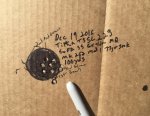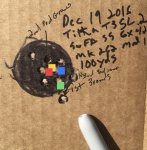- Banned
- #41
16Bore
WKR
- Joined
- Mar 31, 2014
- Messages
- 3,018
You fellas crack me up 
Center your crosshairs on the 10 round group. Now go shoot and have fun.
Center your crosshairs on the 10 round group. Now go shoot and have fun.
Follow along with the video below to see how to install our site as a web app on your home screen.
Note: This feature may not be available in some browsers.
Right. The basic idea is that if you only shot a single 10-shot group, then the best estimate for your 95%-confidence target size is about 1.3 times the size of that group. That estimate would still be pretty noisy.I got distracted at the desk and started thinking along the same lines... tough thing is with groups is it's the max value, not the mean that defines the group... I was thinking one could take group measurements with each consecutive shot to see where the line flattens out. Will be pretty variable among rifles which is maybe why folks just stick with an easy number (like 10).
Yeah, I've spent my fair share of time studying probabilities in college, analyzing data sets and employing statistical methodology in a professional capacity, as well as shooting a decent amount recreationally. I'll go out on a limb and say that like you, I like shooting as well as taking a deeper dive into the math/science behind it. However, you don't need to have a comprehensive understanding of statistical principles to recognize that more data is better than less and that smaller data sets (in terms of round count) are not indicative of the mechanical accuracy of the rifle, ammo, scope, and/or shooter when compared to larger data sets.
For me, I haven't shot a 3-shot group in well over a decade. I typically shoot 5-shot groups, but occasionally will shoot 10- or 15- or 20-shot(ish) groups. I keep records of data, don't call 'fliers', don't wait for the rifle to cool between shots, and aggregate the data over distance and conditions to obtain a broader understanding of my abilities using my equipment. Plenty of guys go into more detail than I do, and plenty don't.
Not to sound rude, but I don't necessarily care what other people do. HOWEVER, when I read someone post 'there's math to support 'X'-process.....the best ballistics testing facility on the entire planet performed a comprehensive study......etc. etc.' I think "that's awesome, I like facts and data, let's see it!" Maybe there's something I could be doing better or maybe there's not - either way I might learn something or just have a good read.
Call me crazy, but I don't take it as gospel when a nameless faceless guy/gal on the internet says "trust me, I'm a secret internet expert". Instead, I prefer to see the data that is actually being referenced so I can make my own decision. Otherwise.....

Yep, that’s a big reason why I don’t waste the time. It’s not barrel harmonics or SD or anything else - I’m the problem.
Yep. Then you gotta sort out the “mistakes” you made. Then the “mistakes” that you constantly repeat that don’t look like “mistakes” because the bullet holes aren’t telling you otherwise.
Then somedays, ya just can’t shoot.
Post up the white paper so we can see the standards, methodology, analyses, correlations, exceptions, conclusions, etc.
Call me crazy, but I don't take it as gospel when a nameless faceless guy/gal on the internet says "trust me, I'm a secret internet expert".
I’ve thought of taking a crack at this one day for the hell of it... taking a pic of the target every shot through my spotting scope and then seeing how the group size grows with shots fired.





If the main purpose of shooting a group is to center the cone over point of aim, and we are shooting past close ranges, than we want to eliminate errors that will lead to misses. In zeroing, being inside of 1 click/increment of the scope helps that. .2mil/.5moa can start to lower hit rates on big game size vitals at medium ranges, but a .1mil/.25moa error doesn’t really show up by itself.
The above target with marks for center of each three round “group” marked. Green is group 1, yellow is group 2, blue is group 3, but red is the actual center.
View attachment 185355
This is actually less shift from each three shot group inside the cone than what is usually seen. Even still there is approx. .2 mil difference between the 1st group and the actual center, a .1 mil between the 3rd group and center.
There is a point of deminishing returns. 3 or 5 shots is not enough for the vast majority of rifles to get a high confidence zero. 30 is more than required for most. The sweet spot is 8-20’ish shots- Anywhere in there is pretty good. 10 just offers a pretty reliable way to be zeroed within one click on the scope, is easy and simple to do, and is half a box of ammo. I personally confirm with a 30 round group for most of my rifles, as most of them are not 2 MOA guns, and I require a extremely high confidence of having POI match POA.
The end result- shoot a bunch of bullets, find the center of all of them (do not use any group reduction nonsense), adjust the center to POA, shoot a bunch more to confirm zero.
Somebody else needs to post up some pictures to get this train wreck back on the rails!
50 year old rifle, 30 year old scope, factory ammo, gave it away last weekend.
There’s statistical significance to a 3 and two 2’s.
View attachment 185612
